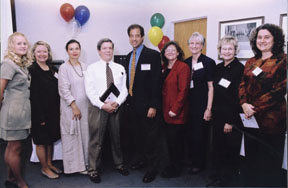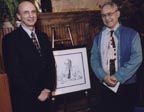
| Home | Contact Us | Site Map | Search |
 |
||||
|
|
|
|
|
| |
|||||||||
|
This file is provided for reference purposes only. It was current when it was produced, but it is no longer maintained and may now be out of date. Persons with disabilities having difficulty accessing information may contact us for assistance. For reliable, current information on this and other health topics, we recommend consulting the NIH Clinical Center at http://www.cc.nih.gov/.

|
|||||||||
CC Pain and Palliative Care Consult Service debutsThe Clinical Center’s new Pain and Palliative Care Consult Service opened in August and already boasts more than 100 patients. The service uses a multidisciplinary approach to manage patient’s pain, and the associated symptoms. "Our multidisciplinary team helps to address the quality of life, pain, and symptom management issues outside of a patient’s protocol," said Dr. Ann Berger, chief of the CC Pain and Palliative Care Consult Service. "This approach helps to treat the whole person and makes them feel better." Patients are referred to the service by their physicians, and after an initial assessment, team members from various CC departments collaborate on the best approach. "We begin by looking at pain and how it affects a patient’s emotional state, and other symptoms," said Dr. Berger. "That way when we bring our team together we can work to pinpoint critical areas of care." Dr. Berger, a former oncology clinical nurse specialist who received medical training at the Medical College of Ohio, initiated palliative care services at both Yale University, and Cooper Hospital/University of Medicine and Dentistry in New Jersey, before joining the CC. The core staff of the service includes Dr. Berger and nurse practitioners Donna Pereira and Karen Baker. The multidisciplinary team includes representatives from rehabilitation medicine, pharmacy, nutrition, anesthesia, spiritual ministry, social work, bioethics, and the CC patient representative. According to Dr. Berger, educating health professionals in the field of pain and palliative care has increasingly received more emphasis in recent years. The American Medical Association has initiated a program to educate physicians on how to provide pain and palliative care, and questions can now be found on the internal medicine board exams. "The JCAHO made pain a fifth vital sign for its accreditation process," said Dr. Berger. "This shows that pain and palliative care is a growing field in the country." But education, says Dr. Berger, is a critical component. The staff has already initiated training for the multidisciplinary team and looks towards providing specialized training for the medical and nursing staff on each patient-care unit. "It is critical for staff to understand and identify the possible components of one’s pain experience so that appropriate treatments can be implemented," said Dr. Jay P. Shah, a physiatrist in the Rehabilitation Medicine Department and a collaborator in the service. "We are integrating nonpharmacologic treatments, such as those we use in physical medicine and rehabilitation, with pharmacologic management," said Dr. Shah. "It’s a pyramid strategy: first we try to manage pain with physical and psychosocial modalities, and then introduce drugs as needed. Many patients have benefited tremendously." Timing is everything when it comes to these issues, say the program planners. "We are here for patients from day one of their illness, not only for end-of-life issues," said Dr. Berger. Patients who are experiencing anything from fear and anxiety, to nausea and vomiting are encouraged to participate in the service. "It’s a patient's quality of life that makes all the difference. We not only have to cure the illness, we have to take care of the person," said Dr. Berger. "More and more patients are saying that they want both. That is our purpose, to give them both." Outpatient clinics are held Mondays and Thursdays in OP3. Inpatients are seen all week. For more information, call 4-9767. (by LaTonya Kittles)
|
 |
| Present for the reception for the new clinic were (left to right) KaLea Kunkle, speaker; Renee Thomas, AJAO chair; Dr. Raphaela Goldbach-Mansky, NIAMS; Dr. Peter Lipsky, NIAMS; Dr. Robert Lipnick, clinic co-director; Dr. Janet Austin, NIAMS; Janet Jones, NIAMS; Ann Kunkel, juvenile arthritis advocate; and Dr. Barbara Mittleman, NIAMS. |
NIH officially opened its first pediatric rheumatology clinic during a reception held on September 21. NIAMS, which sponsored the reception, organized the specialty clinic at the CC.
The clinic offers diagnosis, evaluation, and treatment for children with arthritis and other chronic rheumatic diseases. It also serves as a specialty care facility for children through age 17 who are suspected of having or have a confirmed diagnosis of a rheumatic disease.
"This project represents a coming together of the community and the Clinical Center, and we thank everyone who was involved," said Dr. Peter Lipsky, NIAMS scientific director. "The clinic will help scientists gather research data we so badly need, especially since rheumatic diseases in children varyconsiderably from those in adults."
Dr. Lipsky also spoke on behalf of Dr. Stephen I. Katz, NIAMS director, saying, "Marking the opening of the NIH Pediatric Rheumatology Clinic means making a strong commitment to research for children with rheumatic diseases, which are costly, chronic, and, by nature, devastating. The research information that we gather will ultimately translate into meaningful information and data."
The youngest speaker at the reception, KaLea Kunkel, 16, from Oregon, Mo., has juvenile scleroderma. She, like her three siblings, including one who is adopted, all have a rheumatic disease. "I am here representing the more than 300,000 kids with a rheumatic disease, which may be invisible to the outsider. But the truth is that these irreversible diseases affect every aspect of a child’s life."
Other speakers included KaLea’s mother, Ann Kunkel, who also has a rheumatic disease, and is an advocate for the American Juvenile Arthritis Organization (AJAO). Another speaker, Renee Thomas, chair of AJAO, presented an award to Lipsky and NIAMS for ongoing work in juvenile rheumatic diseases. In speaking about the reception and clinic, Thomas said, "This is a wonderful celebration. Children walking through these doors will be very fortunate. Working together, we can make the dream come true to eventually cure our children who have arthritis."
During the ceremony, CC Director Dr. John Gallin, pledged to assist with the needs of the clinic. "As the clinic project evolves and needs become clear, ask us to help," said Dr. Gallin. "We are fully committed to this project."
The clinic will expose additional doctors to the subspecialty of pediatric rheumatology, an area of medicine that is greatly underserved. According to a 1999 report from the American Board of Medical Specialties, there are only 162 pediatric rheumatologists in the United States, and most are clustered around large cities.
Staffing the clinic are a host of medical professionals from NIH and the private sector, including pediatric rheumatologists, pediatricians, nurse practitioners, research nurses and fellows.
"Rheumatic diseases in children can compromise many developmental and educational tasks," said Dr. Barbara Mittleman, NIAMS director of scientific interchange. "Early and effective treatment can restore or improve the chances of kids with rheumatic diseases enjoying childhood."
"This is a dream come true," said Dr. Robert Lipnick, a pediatric rheumatologist in private practice in Bethesda, who helps staff the clinic along with Dr. Karyl Barron, an NIAID pediatric rheumatologist; and Dr. Raphaela Goldbach-Mansky, an NIAMS pediatrician. "I am extremely excited about this clinic," Dr. Lipnick said. "It will provide a tremendous opportunity for training young physicians to diagnose and treat children with rheumatic diseases and for conducting innovative and unique research studies. It also offers children all over the country the chance to participate."
Pediatric rheumatic diseases include juvenile rheumatoid arthritis, lupus, scleroderma, dermatomyositis, familial fever syndromes, and other chronic diseases that affect the joints, muscles, bones, and skin. (by Janet Howard, NIAMS)
 The
CC hosted a reception last month to honor Dr. Harvey Alter, chief of the Infectious
Disease Section and associate director for research in the Department of Transfusion
Medicine. The reception celebrated Dr. Alter’s receipt of the 2000 Albert
Lasker Award for Clinical Medical Research. The Albert and Mary Lasker Foundation
granted Dr. Alter the award to recognize his work to eliminate the presence
of hepatitis C in the U.S. blood supply. The event included remarks from CC
Director Dr. John Gallin; Dr. Harvey Klein, chief, Department of Transfusion
Medicine; Dr. Michael Gottesman, deputy director for intramural research, NIH;
and Dr. Ruth Kirschstein, principal deputy director, NIH. Dr. Alter was presented
with a portrait by Al Laoang (right), Medical Arts and Photography Branch.
The
CC hosted a reception last month to honor Dr. Harvey Alter, chief of the Infectious
Disease Section and associate director for research in the Department of Transfusion
Medicine. The reception celebrated Dr. Alter’s receipt of the 2000 Albert
Lasker Award for Clinical Medical Research. The Albert and Mary Lasker Foundation
granted Dr. Alter the award to recognize his work to eliminate the presence
of hepatitis C in the U.S. blood supply. The event included remarks from CC
Director Dr. John Gallin; Dr. Harvey Klein, chief, Department of Transfusion
Medicine; Dr. Michael Gottesman, deputy director for intramural research, NIH;
and Dr. Ruth Kirschstein, principal deputy director, NIH. Dr. Alter was presented
with a portrait by Al Laoang (right), Medical Arts and Photography Branch.
briefs |
 NIH
QWL fair hailed a success
NIH
QWL fair hailed a success
The CC QWL Council would like to thank all of the staff involved in this year's NIH QWL fair, held last month. The CC Council provided a host of resources to the community, including handouts, health screenings, and information on the blood donor program at the CC. A "traveling suggestion box" was also available. Staff are reminded to drop any quality-of-work-life suggestions in the box near the B1 and 2nd floor cafeteria exits.
Transhare program enhancedThe Transhare program has had some positive changes recently. Anyone who qualifies will receive the benefit, and the upper level of the benefit amount for Metrochek vouchers has gone up to $65.
For more information call 6-6851 or e-mail: nihparkingoffice@ord.od.nih.gov
Volunteers needed
NINDS researchers seek adults with hypertension for a blood draw. Participants must have an NIH hospital identification number and have had a physical examination at the CC within the past year. Participants will be needed for approximately one hour, and will receive compensation. Appointments will be scheduled at 9:15 a.m. and 10:30 a.m. only. For more information, call Tereza at 6-1115.
Children needed for ADHD studyThe Pediatrics and Developmental Neuropsychiatry Branch of NIMH seeks children 6 to 13 years old, with and without an ADHD diagnosis, to participate in a movement study. Volunteers should have no other history of medical, psychiatric, or neurological disorders (including seizures and hearing problems), and should not be currently taking any prescribed medications. Participation requires a screening interview and neurological examinations. The study will take three to four hours, and participants will be compensated. For more information, call Chris Barker at 6-5323.
Winter blues study
During the winter, are you like a bear that wants to hibernate all the time? If you notice that you feel fatigued and down and that your sleeping and eating habits change in the winter, you may be eligible to participate in a research study on seasonal affective disorder. Diagnostic assessment and treatment consisting of light therapy, psychotherapy, or their combination will be offered. Interested volunteers, 18 or older, are invited to call the Uniformed Services University for more information at (301) 295-9718.
Stress hormones & depression
NIMH researchers seek people with current or past depression to participate in an evaluation study. Participants should be between 18 and 65 years old and otherwise medically healthy. They cannot have smoked within the last year and need to be able to stay at least one night at the CC. Eligible participants will receive a physical evaluation and metabolic studies, and will participate in studies for possible heart disease and osteoporosis in depression. Participants will be compensated. For more information, call 6-5831.
Awards ceremony announced
The Clinical Center Director’s Annual Address and Awards Ceremony will be held on Nov. 13 at 2 p.m. in Masur Auditorium.
Auction set
The CC Department of Laboratory Medicine (formerly Clinical Pathology) announces its 28th annual holiday fundraiser to benefit the Patient Emergency Fund and the Friends of the Clinical Center. Tickets will be on sale Oct. 30-Dec. 7 outside the 2nd floor cafeteria, and the event will be held on Dec. 8,
9 a.m.-2 p.m., in room 2C310. For more information, call Norma Ruschell at 6-4473, or Sheila Barrett at 6-5668.
Clinical research training
Applications for the 2001-2002 NIH-Duke Training Program in Clinical Research are now available in Room B1L403. Designed primarily for clinical fellows and other health professionals training for careers in clinical research, the program offers formal courses in research design, statistical analysis, health economics, research ethics and research management. Courses for this program are offered at the CC by means of videoconferencing from Duke or onsite by adjunct faculty. Students completing the required coursework are awarded a Master of Health Sciences in Clinical Research from Duke University School of Medicine. Prospective participants should consult with their institute or center regarding the official training nomination procedure. Applications must be received by March 1, 2001.
PI training announced
The required course for clinical principal investigators, Clinical Research Training, will be repeated on Dec. 12 from noon-4 p.m. in Lipsett Amphitheater. Topics include ethical issues in human subjects research, roles and responsibilities of the investigator and institution, regulatory issues, and clinical investigators and the mass media.
All principal investigators with a protocol approved through the Clinical Center are required to take the course and successfully complete an exam by March 1, 2001. Registration will be held from Nov. 1-30.
CRC to be discussed
The designers of the new Clinical Research Center, the Zimmer Gunsul Frasca Partnership, will discuss several of their recent design projects, including the CRC, on Nov. 13 from 6:30 to 8:00 p.m. at the National Building Museum in Washington, D.C. The cost is $10 for Museum members, and $14 for nonmembers. To register, call (202) 272-2448, or register online.
On the web:
http://www.nbm.org
Celebrate escort services
Join members of the escort team in celebrating patient escort services Nov. 6-9 from 9 a.m. to 2 p.m. outside the hospitality services office, 1C174. They will sponsor their sixth annual raffle to benefit the Patient Emergency Fund, and the winner will receive exclusive transport services for the patient-care area of their choice. Tickets can be purchased from any member of the patient escort team, and tickets will also be sold outside the second floor cafeteria during lunch hours.
Scrooge visits
The Performing Arts Ensemble will present a musical adaptation of "Scrooge" on Saturday, Dec. 2 at 7 p.m. in Masur Auditorium. Local actors and dancers will star in the extravaganza, and there will be a special appearance by Dale Solly from Channel 7 News. Proceeds from the event will support NIH patients and their families through the Friends of the Clinical Center. Admission is $8 for adults and $4 for children 12 and under. For tickets, call 4-5596.
No more receipts
The annual receipt drives to benefit the NIH School has new rules–no more receipts needed. To help the NIH School earn free educational equipment, shoppers at Safeway and Giant Foods need only register for a club card and give the school code: Giant #2983, and Safeway #0623. Then registered shoppers will automatically earn credit for the school every time they use their club cards. The NIH School can even earn double credit when customers purchase selected products which are clearly designated at the stores. Both the Safeway Club Card for Education Program, and the Giant A+ Bonus Bucks Program run until the end of March 2001. For more information call the NIH School at 6-2077, or e-mail: hmays@mail.cc.nih.gov.
|
Clinical Center News, 6100 Executive Blvd., Suite 3C01, MSC 7511, National Institutes of Health, Bethesda, MD 20892-7511. Tel: 301-496-2563. Fax: 301-402-2984. Published monthly for CC employees by the Office of Clinical Center Communications, Colleen Henrichsen, chief. News, article ideas, calendar events, letters, and photographs are welcome. Deadline for submissions is the second Monday of each month. |
|
|